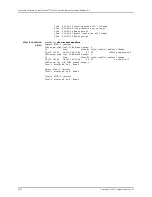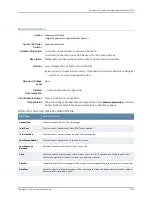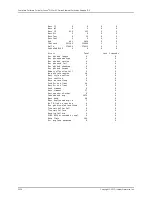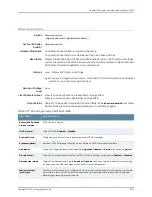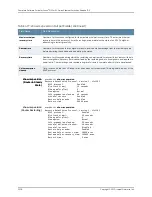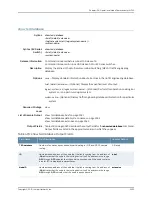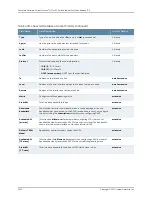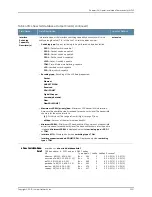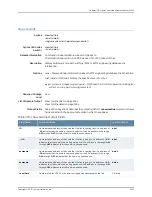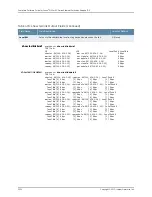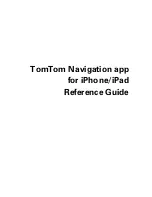
Table 475: show rsvp session Output Fields
(continued)
Level of Output
Field Description
Field Name
detail extensive
LSP type:
•
Link protected LSP
—LSP has been protected by link protection at the outgoing
interface. The name of the bypass used is also listed here (
extensive
).
•
Node/Link protected LSP
—LSP has been protected by node and link
protection at the outgoing interface. The name of the bypass used is also
listed here (
extensive
).
•
Protection down
—LSP is not currently protected.
•
Bypass LSP
—LSP that is used to protected one or more user LSPs in case of
link failure.
•
Backup LSP at Point-of-Local-Repair (PLR)
—LSP that has been temporarily
established to protected a user LSP at the ingress of a failed link.
•
Backup LSP at Merge Point (MP)
—LSP that has been temporarily established
to protected a user LSP at the egress of a failed link.
Type
extensive
New bypass (the bypass name is also displayed) has been activated to protect
the LSP.
New bypass
extensive
Link protection (the bypass name is also displayed) has been activated for
the LSP.
Link protection up,
using bypass-name
extensive
A
link down
event occurred, and traffic is being switched over to the bypass
LSP.
Creating backup
LSP, link down
extensive
Link has come back up and the LSP has been restored. Because the backup
LSP is no longer needed, it is deleted.
Deleting backup
LSP, protected LSP
restored
detail
Displays the value of the path MTU received from the network (through
signaling) and the value used for forwarding. This value is only displayed on
ingress routing devices with the
allow-fragmentation
statement configured at
the
[edit protocols mpls path-mtu]
hierarchy level. If there is a detour LSP, the
path MTU for the detour is also displayed.
Path mtu
detail
Address of the previous-hop (upstream) routing device or client, interface the
neighbor used to reach this routing device, and number of packets received
from the upstream neighbor.
PATH rcvfrom
detail
MTU signaled from the ingress routing device to the egress routing device by
means of the adspec object.
Adspec
detail
Address of the next-hop (downstream) routing device or client, interface used
to reach this neighbor (or peer-name in the GMPLS LSP case), and number of
packets sent to the downstream routing device.
PATH sentto
detail
Explicit route for the session. Normally this value will be the same as that of
record route. Differences indicate that path rerouting has occurred, typically
during fast reroute.
Explct route
3519
Copyright © 2010, Juniper Networks, Inc.
Chapter 126: Operational Mode Commands for MPLS
Summary of Contents for JUNOS OS 10.3 - SOFTWARE
Page 325: ...CHAPTER 17 Operational Mode Commands for System Setup 229 Copyright 2010 Juniper Networks Inc ...
Page 1323: ...CHAPTER 56 Operational Mode Commands for Interfaces 1227 Copyright 2010 Juniper Networks Inc ...
Page 2841: ...CHAPTER 86 Operational Commands for 802 1X 2745 Copyright 2010 Juniper Networks Inc ...
Page 3367: ...CHAPTER 113 Operational Mode Commands for CoS 3271 Copyright 2010 Juniper Networks Inc ...
Page 3435: ...CHAPTER 120 Operational Mode Commands for PoE 3339 Copyright 2010 Juniper Networks Inc ...
Page 3529: ...CHAPTER 126 Operational Mode Commands for MPLS 3433 Copyright 2010 Juniper Networks Inc ...


















